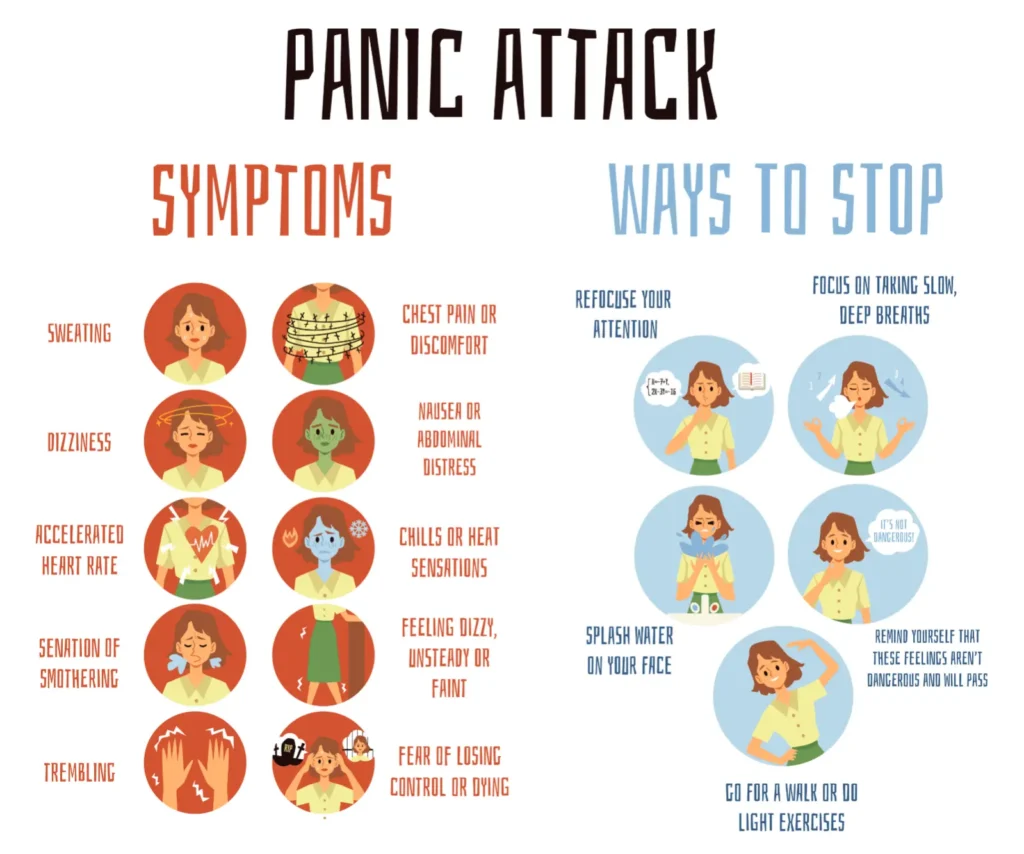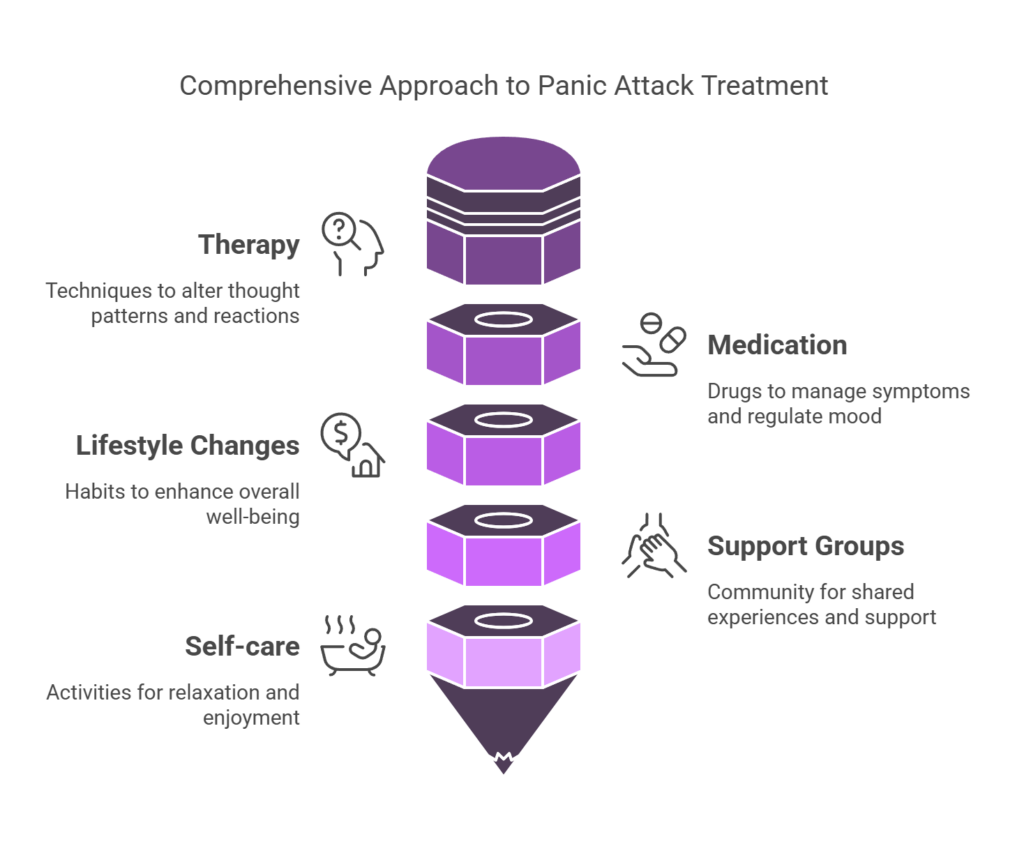Discovering the underlying causes of panic attacks can be like peeling back the layers of a mysterious puzzle. These sudden surges of overwhelming fear and anxiety can strike without warning, leaving individuals feeling helpless and desperate for answers.
In this blog, we will get on a journey to unmask the hidden triggers behind panic attacks, shedding light on their complex origins and unraveling the symptoms that often accompany them.
While panic attacks can feel debilitating, understanding their root causes is essential in developing effective strategies for managing and preventing them. From biological factors, such as brain chemistry imbalances, to environmental influences like stress and trauma, we explore the intricate web of factors that contribute to the onset of panic attacks.
By uncovering these triggers, individuals can gain a greater understanding of their own experiences, empowering them to take control of their mental well-being.
Join us as we delve into the many sides of panic attacks, debunking misconceptions and shedding light on the hidden triggers that can often go unnoticed.
By unraveling the causes and symptoms of panic attacks, we aim to offer hope, support, and guidance to those who find themselves in the grips of this overwhelming condition.
Stop Suffering in Silence!
What are the causes of Panic attacks?
In order to understand panic attacks, it’s helpful to first understand what anxiety is. Anxiety is often described as being either excessive or unfounded fear and is a common psychological disorder worldwide. It can manifest in diverse ways and differs from one individual to another. Someone can be diagnosed with more than one anxiety disorder at the same time.
Panic attacks are very unpleasant and are often accompanied by feelings of dread, terror, and helplessness. They can cause feelings of anxiety and make it impossible for you to carry on with normal life. The causes of panic attacks are varied and are usually related to problems in your past which may have been caused by trauma or abuse.
Here are some of the key contributors to what causes panic attacks:
- Genetics: Research suggests that there may be a genetic component to panic attacks. If you have a family history of panic disorder or other anxiety-related conditions, you might be at a higher risk of experiencing panic attacks. Specific genetic variations may make some individuals more susceptible to heightened anxiety responses.
- Neurotransmitter Imbalances: Neurotransmitters are chemicals in the brain that regulate mood and anxiety. An imbalance in neurotransmitters, particularly serotonin and norepinephrine, can contribute to the development of panic attacks. These imbalances can affect the brain’s ability to manage and respond to stress.
- Stress and Anxiety: High levels of stress and anxiety are common triggers for panic attacks. Stressors can come from various sources, such as work, relationships, financial pressures, or significant life changes. Chronic stress can lead to heightened sensitivity to anxiety, making panic attacks more likely.
- Trauma and Past Experiences: Previous traumatic experiences, such as accidents, abuse, or the sudden loss of a loved one, can increase the risk of panic attacks. These experiences may leave individuals more vulnerable to anxiety and panic.
- Phobias: Specific phobias, like fear of flying or fear of enclosed spaces (claustrophobia), can lead to panic attacks when confronted with the feared situations. The brain’s fear response can become overwhelming in these situations, triggering a panic attack.
- Medical Conditions: Some medical conditions can mimic the symptoms of panic attacks. Conditions like hyperthyroidism or chronic respiratory problems can lead to physiological changes that induce panic-like symptoms. It is important to rule out underlying health issues.
- Substance Abuse: The use of drugs, alcohol, or certain medications can induce panic attacks. Additionally, withdrawal from these substances can trigger panic attacks as the body reacts to the absence of the substance.
- Personality Factors: Certain personality traits, such as perfectionism or a tendency to be overly self-critical, can contribute to the development of panic attacks. These traits may increase the likelihood of experiencing anxiety and panic.
Panic attacks should be taken seriously and treated as soon as possible as they could be brought on by other health conditions such as stress, medications, or psychiatric issues.
All Symptoms of Anxiety and Panic Attacks
Everyone gets anxious, but when a person suffers from panic attacks, they feel like a situation is beyond their control and they can’t cope with their own thoughts and feelings.

Panic attacks manifest with a combination of physical and psychological symptoms, typically peaking within a few minutes before gradually subsiding. Common symptoms include:
- Intense Fear: A sudden, overwhelming sense of fear and impending doom is the core feature of a panic attack. This fear can be irrational and paralyzing.
- Rapid Heartbeat: Heart palpitations and a pounding heart are frequent during an attack, intensifying the sense of impending catastrophe.
- Shortness of Breath: Many individuals experience difficulty breathing, often feeling as though they are choking or suffocating.
- Sweating: Profuse sweating, even in a cool environment, is a typical symptom of panic attacks.
- Trembling or Shaking: Uncontrollable trembling or shaking, particularly in the hands and legs, can occur during an episode.
- Chest Pain or Discomfort: Chest pain or discomfort is often mistaken for a heart attack, further exacerbating anxiety during an attack.
- Nausea or Abdominal Distress: Some people may feel nauseated or experience stomach discomfort, adding to the overall discomfort.
- Dizziness or Lightheadedness: Feeling faint or dizzy is another common symptom, contributing to the sense of losing control.
- Hot Flashes or Chills: Sudden sensations of heat or cold can accompany panic attacks, intensifying the overall distress.
- Fear of Losing Control or Going Crazy: Many individuals fear that they are losing their sanity during an attack, adding to the emotional turmoil.
- Fear of Death: Some may feel as though they are about to die during a panic attack, intensifying the sense of impending doom.
- Numbness or Tingling: Sensations of numbness or tingling in the extremities can be reported, contributing to the overall discomfort.
Although the symptoms of panic may be unpredictable, there are many causes of these attacks that can help in treating this condition.
Your Path to Recovery Begins Here
Misconceptions related to panic attacks!
Panic attacks can be highly distressing, and there are several common misconceptions associated with them that need to be dispelled. Here are some of the misconceptions:
Misconception: Panic Attacks Are a Sign of Weakness
Reality: Panic attacks are not a sign of weakness. They are a result of a complex interplay of psychological, genetic, and environmental factors. Anyone, regardless of their strength or resilience, can experience panic attacks.
Misconception: Panic Attacks Are Always Triggered by Stress or Anxiety
Reality: While stress and anxiety are common triggers, panic attacks can also occur in the absence of an obvious stressor. Some individuals experience panic attacks seemingly out of the blue, which is known as “spontaneous panic attacks.”
Misconception: Panic Attacks Are Just a Response to Fear
Reality: Panic attacks often involve intense fear, but they can also be triggered by physical sensations, such as an irregular heartbeat or dizziness, without any specific fear. Panic attacks are a complex mind-body response.
Misconception: Panic Attacks Are Harmful and Life-Threatening
Reality: While panic attacks can be extremely distressing, they are not physically harmful or life-threatening in and of themselves. They are primarily a result of a fight-or-flight response in the body.
Misconception: Only People with Panic Disorder Experience Panic Attacks
Reality: Panic attacks can affect individuals who do not have panic disorder. They can occur in the context of other anxiety disorders, as part of a medical condition, or as a response to specific stressors.
It’s important to approach these experiences with empathy, creating a more supportive environment for individuals dealing with panic attacks.
How are Panic Attacks Treated

The Final Say:
Panic attacks should not be underestimated or stigmatized. They are complex and can affect anyone, regardless of their strength or resilience. By acknowledging the root causes and symptoms, we take a step toward reducing the stigma surrounding panic attacks and offer a helping hand to those who need it. Remember, you are not alone, and support is available for managing and overcoming this challenging condition.









